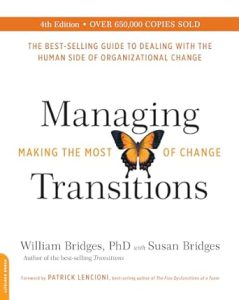In today’s fast-paced and ever-evolving business landscape, change is a constant. Organizations must constantly adapt to stay competitive, relevant, and successful. One of the key players in driving and managing change within an organization is the Human Resources (HR) department. HR plays a crucial role in change management, as they are responsible for shaping the organization’s culture, guiding employees through transitions, and ensuring that the organization’s goals and objectives are met.
In this blog post, we will explore the important role that HR plays in change management and the strategies they can employ to facilitate successful and sustainable change within an organization.
What are the 4 principles of change management
Although using the word “I” is not possible I can describe the four pillars which support successful change management. Every company needs to follow four essential principles to successfully implement changes. These principles consist of a well-defined vision for change along with a strong support team and a detailed plan that is achievable and complemented by an effective communication strategy. The four pillars are essential for achieving organization-wide acceptance and adoption of change. Organizations that implement these guidelines will manage change effectively while creating benefits for all members. Sticking to established principles together with maintaining flexibility for adjustments creates a successful change management process.
1. Understand the Change
Successful change requires total comprehension of the transition process. Organizations must evaluate their current situation to identify necessary changes and set desired outcomes. This method enables us to anticipate the potential impacts that changes might create for people as well as business processes and technological systems. The process enables the development of a change plan that incorporates steps to be taken, deadlines to meet and lists of potential challenges with their corresponding solutions. Organizations improve their capacity to handle change and achieve their objectives through an in-depth understanding of the change process.
2. Plan for Change
Successful change management begins with developing an organized plan for the proposed change. Successful change management requires goal setting and resource allocation alongside timeline creation and involvement of key stakeholders. The planning process must include an assessment of potential challenges along with strategies for addressing them. Successful transition requires clear communication with all stakeholders. A comprehensive plan helps to avoid unexpected problems and ensures the change process runs more smoothly. Implementing the plan builds trust and confidence among all participants.
3. Implement Change
The following essential phase in change management requires translating the change plan into active implementation. The change implementation step requires executing the strategy and bringing the transformation to life. Open communication throughout this phase helps to manage resistance and achieve universal acceptance of the change. The implementation process requires training employees as well as recruiting new staff members while updating procedures and purchasing new tools and technology. It’s essential to track progress while making necessary adjustments and to acknowledge milestones to maintain motivation among team members. The primary objective is to ensure all team members are fully engaged and dedicated to finishing the project.
4. Communicate Change
During my work as a virtual assistant I sometimes need to notify clients about future modifications to our services. Change brings about fear and discomfort which makes it challenging to manage. Experience has shown me that successful transitions depend on effective communication.
The first step to communicate changes effectively is to recognize the existing situation. I highlight the beneficial aspects of changes while outlining client preparation steps. Listening to clients’ concerns is crucial. I demonstrate my understanding and attentiveness by providing answers to their questions and addressing their concerns. It is important to approach change with kindness and understanding because people respond differently to it.
Examples of Organizational Change
In my role as a virtual assistant I understand that businesses need to adapt to market changes. These examples illustrate possible structural changes a company may undergo.
- Restructuring: Organizational restructuring means altering employee structures while creating new teams and removing existing ones.
- Process improvement: Enhanced work processes lead to greater business efficiency and effectiveness.
- Mergers and acquisitions: By forming partnerships or acquiring other businesses a company can expand its customer base while improving its operational capabilities.
- Change in leadership: The change in company leadership leads to significant shifts in organizational direction as well as employee behavior and daily operational activities.
- Digital transformation: Technology implementation enables companies to function more efficiently while increasing customer satisfaction and gaining advantage over competitors.
- Downsizing: Several businesses have decreased their number of employees to cut costs and enhance operational performance.
- New product development: Businesses consistently introduce new products and services to attract more customers and increase their sales.
Different kinds of changes occur within companies over time. Effective communication and inclusion of all essential stakeholders are critical elements for successful change implementation.
5 Contributions of HR to Change Management
1. HR facilitates communication of the change
My experience in human resources has shown me that clear communication plays an essential role in the workplace. During significant organizational changes such as mergers or strategic shifts, companies must maintain clear communication with their employees. That’s where human resources steps in. We ensure managers and employees maintain open communication so everyone understands current developments and future expectations. Through this process employees develop trust and openness while maintaining a positive feeling. Our HR team deserves praise for their dedicated efforts to enhance communication throughout organizational change periods.
2. Develop training programs to build toward changes
Through training programs employees gain the necessary skills to understand and adjust to workplace changes. Organizational changes might include adopting new technology systems along with revised operational procedures and organizational restructuring. Understanding both the nature of workplace changes and their effects on employees forms the foundation of effective training program development. Understanding these dynamics allows organizations to pinpoint essential skills and knowledge employees need to handle changes effectively.
3. Track performance and engagement to review the effects of change
Through my HR background I understand the importance of observing employee reactions to workplace rule changes. Without reviewing the outcomes you cannot determine whether the changes were effective or require additional modifications. You must create specific goals that you can track over time to evaluate your progress. These goals can be measured by looking at the amount of work completed alongside employee satisfaction and client feedback. Monitoring changes before and after implementation reveals whether improvements have occurred. Maintaining employee communication and listening to their opinions plays a critical role in workplace operations. By holding meetings with employees and conducting focus groups or surveys you can assess their emotions and work performance.
4. Ensure any new strategy or policy aligns with the company’s culture
5. Change Management: Building a stronger future
Working in change management can be tough. Change management involves implementing significant workplace changes which can present complex challenges. Implementing change management requires strategic thinking which includes aligning team members and maintaining clear communication along with tracking the progress of changes over time. Change management presents significant advantages despite its difficult nature. Change management prepares businesses to face a brighter future through increased adaptability, creativity, and success. Companies that handle change with careful consideration grow stronger and enhance their ability to overcome difficulties.
5 must-read books for change management
Change management is a crucial process in today’s fast-paced business world. It involves carefully planning, implementing, and monitoring changes within an organization to ensure they are successful and well-received. If you’re interested in learning more about change management, here are five recommended books to read:
- “Leading Change” by John P. Kotter: John P. Kotter: John Kotter knows a lot about guiding big changes, and his book is a great tool for learning how to deal with change. In “Leading Change,” he gives a clear plan for managing change based on his research and experience.
- “Switch: How to Change Things When Change Is Hard” by Chip Heath and Dan Heath: Adapting to new situations can be challenging, but the Heath brothers offer helpful advice in their book, “Switch.” They blend psychology and storytelling to provide a roadmap for handling transitions.
- “The Change Book: How Things Happen” by Mikael Krogerus and Roman Tschäppeler: “The Change Book” is a helpful guide that explains 50 important ways to handle change. Each method is shown in a clear two-page layout, making it simple to grasp and use. This book provides various strategies for making changes, like good communication, getting help, and dealing with challenges.
- “Managing Transitions: Making the Most of Change” by William Bridges: William Bridges’ book, “Managing Transitions,” talks about how people handle change. He looks at the feelings people have during transitions and gives tips on how to deal with them.
- “The Heart of Change: Real-Life Stories of How People Change Their Organizations” by John P. Kotter and Dan S. Cohen: In the book “The Heart of Change” by Kotter and Cohen, the authors share stories of successful businesses that have made major changes.
Conclusion
Businesses need effective change management to navigate new challenges and capitalize on new opportunities. Organizations can reduce resistance and enhance benefits during change by communicating changes effectively and providing employee support and training while involving them in the process. Adopting change management practices results in higher productivity as well as improved employee satisfaction which contributes to organizational success.



